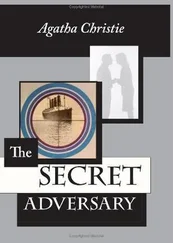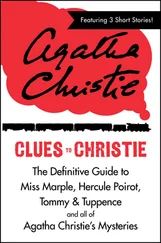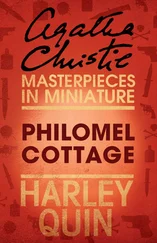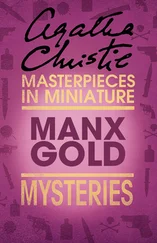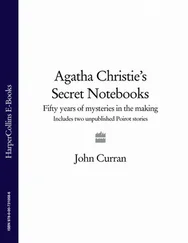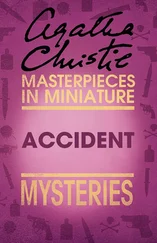This was among the last notes to appear, written as it was just before the publication of Postern of Fate:
 Nov. 2nd 1973 Book of Stories
Nov. 2nd 1973 Book of Stories
The White Horse Stories
First one—The White Horse Party (rather similar to Jane Marple’s Tuesday Night Club)
Chapter 25 of Four-Fifty from Paddington includes a brief, cryptic reference to A Murder is Announced, but without mentioning the title…
 Somebody greedy—bit about Letty Blacklock
Somebody greedy—bit about Letty Blacklock
…while this reference appears during the plotting of Third Girl:
 Poirot worried—old friend (as in McGinty) comes to tea
Poirot worried—old friend (as in McGinty) comes to tea
Finally, the idea of reintroducing Sergeant Fletcher from A Murder is Announced was briefly considered during the plotting of A Pocket Full of Rye:
 Chapter II—Crossways—Inspector Harwell—or Murder is Announced young man
Chapter II—Crossways—Inspector Harwell—or Murder is Announced young man
5
Blind Man’s Buff: A Game of Murder
The ping of two bullets shattered the complacency of the room. Suddenly the game was no longer a game. Somebody screamed…
A Murder is Announced, Chapter 3
SOLUTIONS REVEALED
The A.B.C. Murders • Dead Man’s Folly • ‘ Manx Gold ’ • The Mirror Crack’d from Side to Side • A Murder is Announced • One, Two, Buckle my Shoe • Peril at End House • ‘Strange Jest’ • Why Didn’t They Ask Evans?
‘Shattering the complacency’—this is the dramatic impact of a game going wrong in three Christie titles; while two others are actual games, one intellectual and one physical. The deadliest game of the three titles is The A.B.C. Murders, while the other two, Dead Man’s Folly and A Murder is Announced, feature actual games that go wrong due to the intervention of a real murder. ‘Strange Jest’ and ‘Manx Gold’ are intellectual puzzles played by characters with a tangible prize at the end. The latter was an actual game played in the Isle of Man in 1930, while the former concerns the interpretation of a will. And the game played by Clarissa in Spider’s Web proves to be more dangerous than even she realises. In Christie’s overall output the concept of the game-going-wrong is not a major motif, but the dramatic impact of the scene in the drawing-room at Little Paddocks in A Murder is Announced cannot be denied.
‘Manx Gold’ May 1930
Cousins Juan and Fenella race to find a treasure as they match wits with their dead uncle—and a killer.
A full history of this story can be found in the 1997 collection While the Light Lasts, thanks to sterling detective work by its editor Tony Medawar. Briefly, the chairman of a tourism committee in the Isle of Man approached Christie, in late 1929, with a view to her creating a treasure hunt on the island to boost tourist numbers. After a visit in April 1930 she wrote ‘Manx Gold’, for a fee of £65 (approx. £1,300 today), and it was published in five instalments, complete with clues, in the Manchester Daily Dispatch, in the third week of May of that year, and in a booklet distributed throughout the island. The ‘treasure’ was four snuffboxes hidden in separate locations around the island. (It is at an exhibition of snuffboxes that Hercule Poirot meets Mr Shaitana in Cards on the Table.)
Notebook 59 has 20 pages of notes for this unusual commission. Unfortunately those pages contain some of the most indecipherable notes of any of the Notebooks, including much crossing out, doodling and rough diagrams. The story is a minor entry in her literary output, remarkable mainly for the uniqueness of its creation and for the number of ideas that were to resurface in a book four years later. A snapshot and a dying man’s last words as well as a villainous doctor are all features of Why Didn’t They Ask Evans?. And, indeed, Juan and Fenella, a couple joining forces to elucidate a mystery, could be seen as forerunners of Bobby Jones and Lady Frances Derwent from the same novel. (Oddly, Juan and Fenella are both fiancés and first cousins.) The invisible ink idea first surfaced in Motive Vs. Opportunity two years earlier and as minor plot element in Chapter 20 of The Secret Adversary.
The notes accurately reflect the story as it appeared. There were however some name changes—Ronald and Celia become Juan and Fenella and Robert becomes Ewan—while the cliff fall and cuff-link clue were eventually discarded:
Story
Ronald and Celia—first cousins—letter from deceased uncle. Her annoyance about uncle—they arrive—the housekeeper—4 snuff boxes missing. Letter left—with doggerel rhyme—call at lawyers. Then they start off—get it—on their return—meet the others—Dr Crook [Crookall was the name of the chairman of the Tourism Committee!] MacRae—Alan—Robert Bagshawe…doesn’t like his smile. They decide to pool with others. Next day—the clues—housekeeper goes to get them—stolen—she admits that they asked her and she refused—a cuff link—it was Robert.
They dash out—find R in grounds—dying—murdered—hit on head or in hospital—has fallen over cliff. They lean near him—may be conscious at end—opens eyes says ‘D’ye ken—?’—dies
The ‘doggerel rhyme’ referred to above appears in Notebook 59 in two forms, the one that actually appeared and the following, an earlier unused draft:
4 points of the compass so there be, South and West North and East
A double S—No East for me Fare forth and show how clever you be.
Two of the other clues also appear:
Excuse verbosity—I am all at sixes and sevens and Words brought out by heat of fire
Another point of interest in this Notebook is a rough drawing of the clue that falls out of the map of the island—a cross, a circle and a pointing arrow down to the detail of the little lines on one side of the circle, as noticed by Fenella.
The A.B.C. Murders 6 January 1936
A series of letters to Hercule Poirot challenges him to a deadly game. Despite these forewarnings, the letter-writer manages to kill Alice Ascher in Andover, Betty Barnard in Bexhill, and Sir Carmichael Clarke in Churston. As the entire country watches, can Poirot prevent the D murder?
Thanks to Notebook 13, we have an exact date for the writing of this novel. There, during a 15-page travel account, we read the following, although unfortunately there are no further references in the travelogue to the progress of the novel:
Tuesday November 6th [1934] Started The A.B.C. Murders.
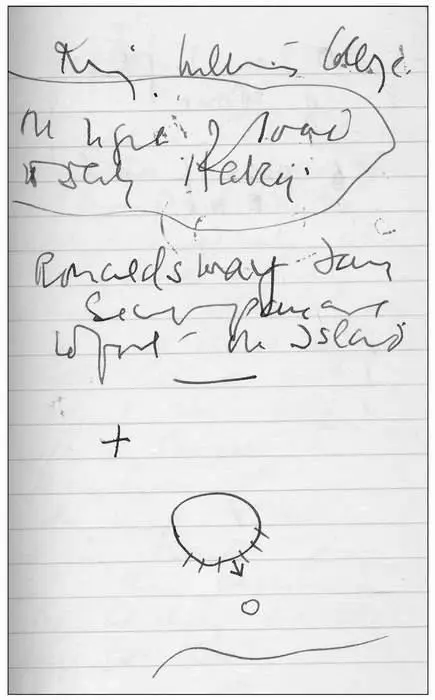
A rough sketch (and even rougher handwriting!) of a clue in the search for Manx Gold, from Notebook 59.
Featuring a hugely imaginative concept—an alphabetical series both of murder victims and locations, chosen apparently at random—that was carried off with consummate skill and daring, The A.B.C. Murders was destined to become one of the top three Christie titles. And it is now forgotten that it was one of the earliest versions of the ‘serial killer’ idea that is now a staple of both the bookshelf and the screen. When this book was written the phrase did not even exist and is yet another example of Christie anticipating, without even realising it, motifs that were to dominate crime fiction in later years. (The other major anticipation was Death Comes as the End, set in Ancient Egypt and foreshadowing another current trend for crime novels set in various eras of the past.)
Читать дальше
Конец ознакомительного отрывка
Купить книгу
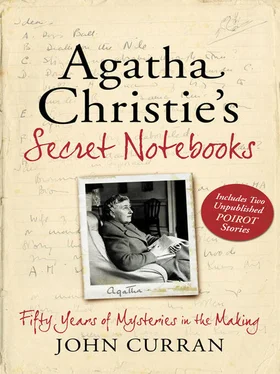
 Nov. 2nd 1973 Book of Stories
Nov. 2nd 1973 Book of Stories

